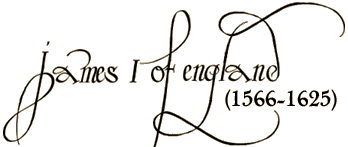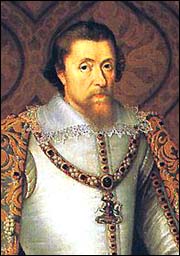 |

by John Butler
 James I of England and VI of Scotland was born in 1566, the son of Mary, Queen of Scots, and Henry, Lord Darnley. James had to
face difficulties from his earliest years—his mother was an incompetent
ruler who quarrelled with politicians and churchmen such as John Knox,
and she may have been involved in the murder of her husband Darnley, himself a worthless character. The murder was
carried out partly to avenge the slaying of Mary's secretary and possible lover, David Rizzio or Riccio, in which Darnley played a part
(before James's birth), and it also enabled Mary to marry her current lover, the Earl of Bothwell. Mary was deposed by the Scottish lords in 1567, and fled to England, where she sought the protective
custody of Elizabeth I, who clapped her in prison and had her
beheaded twenty years later. James I of England and VI of Scotland was born in 1566, the son of Mary, Queen of Scots, and Henry, Lord Darnley. James had to
face difficulties from his earliest years—his mother was an incompetent
ruler who quarrelled with politicians and churchmen such as John Knox,
and she may have been involved in the murder of her husband Darnley, himself a worthless character. The murder was
carried out partly to avenge the slaying of Mary's secretary and possible lover, David Rizzio or Riccio, in which Darnley played a part
(before James's birth), and it also enabled Mary to marry her current lover, the Earl of Bothwell. Mary was deposed by the Scottish lords in 1567, and fled to England, where she sought the protective
custody of Elizabeth I, who clapped her in prison and had her
beheaded twenty years later.
James grew up under various regencies and a couple of notable tutors, the poet, dramatist and humanist George Buchanan, and Peter
Young, whose good nature and enthusiasm for lighter reading somewhat offset the formidable learning and sometimes overbearingly
serious teaching methods of Buchanan. James chafed against Buchanan and disliked him, but in later years would boast that he had
been the great man's pupil. Buchanan instilled in James political theories which included the idea that the king is beholden to the
people for his power, a belief which James later came to reject in favour of Divine Right kingship. From Young he learned to appreciate poetry (Buchanan wrote Latin poetry of a largely didactic
nature, and encouraged James to read mostly Latin and Greek books) and delved deeply into his mother's library of French verse and
romances. James developed a genuine love of learning (he was not, as many authors have claimed, a mere pedant), some skill in
writing poetry, and a lively prose style. He also showed an interest in plays, including those of Shakespeare and Jonson, and was particularly fond of the masque, which would become the
leading form of court entertainment when James became King of England in 1603. His marriage to Anne of Denmark, herself a great patron of masques and a connoisseur of literature, may have piqued his interest in this particularly royal form of entertainment, with its
music, dancing, singing and elaborate sets designed by Inigo Jones. Of the children of King James and Queen Anne, only three survived to adulthood: Henry, Prince of Wales, who died untimely in 1612, possibly of typhoid fever, Charles, who succeeded his father as king, and Princess Elizabeth, who married Frederick V, Elector Palatine.
James published his first book in 1584, entitled The Essays of a Prentice in the Divine Art of Poesy, which he followed up in 1591 with His Majesties Poetical Exercises at Vacant Hours. In the first book James included some translations he had made from du Bartas, whose Uranie takes the muse Urania and transforms her into a Christian figure representing the Holy Spirit, an idea which appealed to James at the time, because he thought he could employ poetry for the dissemination of his religious and political beliefs. As a King, James had a special relationship with God and could therefore write religious poetry from a special viewpoint. James's poetry is competent, and sometimes he manages a striking line or two; one of his best poems is the sonnet he wrote prefacing his book Basilikon Doron (1599).
The majority of James's written works are
concerned with theology and the justification of the theory of Divine
Right, and for those
reasons he must be considered as a major writer of political
philosophy. In lively style and with considerable learning he defended
the
Oath of Allegiance which Catholics were required to take, disputed it
with the great Cardinal
Bellarmine, wrote two books on
Divine Right, one, Basilikon Doron, for the edification of his
son Prince
Henry (1594-1612) and the other, The True Law of Free
Monarchies, was a simple explanation of his theories for the
general literate public. D.H. Willson, one of James's biographers,
calls
the first book "entertaining and quotable" (133) and also cites Francis Bacon as
finding that it "filled the whole realm as with a good
perfume or incense, being excellently written and having nothing of
affectation" (166). James's comment on Bacon's Advancement of
Learning was "it was like the peace of God, which passeth all
understanding" (Ashton 142). James also wrote some
rather moving "Meditations on the Lord's Prayer" and a justly famous
essay, "A
Counterblast to Tobacco" (1604), one of the first,
and surely one of the best attacks on smoking ever written. Smoking,
James tells us, is "a custom loathsome to the eye, hateful to the
nose, harmful to the brain, dangerous to the lungs, and in the black,
stinking fume thereof, nearest resembling the horrible Stygian
smoke of the pit that is bottomless."
James's interest in literature was tied in
with a shrewd sense of propaganda. He realised that books, masques,
sermons, and plays
could all be employed in the service of the king, that they were the
media which could best disseminate his views of kingship and
impress upon a large number of people its power and majesty. The court
masque, expensive and elaborate, baroque and ritualistic,
symbolised that power and majesty, and the king's physical place as the
focal point of the entertainment reinforced it further. Thus
James and Queen Anne patronised Ben Jonson and Inigo Jones, the great
architect and designer of the sets for Jonson's masques.
The publication of sermons, also, was of particular interest to the
theologically-minded king, and his personal encouragement of the
church career of John
Donne, whom James appointed Dean of St. Paul's Cathedral, was no
accident, for Donne was a staunch
supporter of kingly power and majesty, and often preached before the
King himself, as did his eminent colleague Lancelot Andrewes,
another of James's favourite divines.
James's political accomplishments (or lack
thereof) as King do not concern us here, but suffice it to say that he
has had a mixed
reception from historians. Most agree that he was a success in Scotland
but a partial failure in England, although recently his English
kingship has undergone massive studies by Conrad Russell and others
which have tended to show James in a much more favourable
light. For example, he consistently strove for peace both at home and
abroad, with varying success, but was determined never to go to
war if it could be helped.
James I's impact on English literature is
considerable, not least because of his encouragement of and
participation in the translation of the
Bible into English (1611), the translation that many people still
consider the best, and which bears his name, the King James Bible.
That, above everything he wrote, is James's monument, but his literary
works deserve some credit, and he is always a pleasure
to read.
SELECT BIBLIOGRAPHY
1. Editions of James's works
- King James VI and I. Political
Writings. Johann P. Sommerville, Ed.
Cambridge University Press, 1994.
- Craigie, James, Ed. The Poems of James
VI of Scotland.
Edinburgh: Scottish Early Text Society, Vols. 22 and 26, 1955 and
1958.
- Craigie, James. "Last Poems of James VI."
Scottish Historical Review 29 (1950), 134-42.
- McIlwain, C.H., Ed. The Political Works
of James I.
Cambridge, Mass.: Harvard University Press, 1918.
2. Biographies
- Fraser, Antonia. King James VI of
Scotland and James I of England.
London: Weidenfeld and Nicolson, 1974.
- Lee, Maurice. England's Solomon: James
VI and I in his Three Kingdoms.
Urbana: University of Illinois Press, 1990.
- Mathew, David. King James I.
London: Jonathan Cape, 1982.
- Willson, D.H. King James VI and I.
London: Jonathan Cape, 1958.
3. Studies
- Butler, John. James I
and Divine Right.
Tokyo: Sophia University Renaissance Institute Monograph Series, 1999.
- Peck, Linda L., Ed. The
Mental World of the Jacobean Court.
Cambridge University Press, 1991.
- Goldberg, Jonathan. James
I and the Politics of Literature: Jonson,
Shakespeare, Donne and their Contemporaries.
Baltimore:
Johns Hopkins University Press, 1983.
- Russell, Conrad. Parliament and English
Politics 1621-1629.
Oxford: Oxford University Press, 1979.
- Wormald, Jenny. "James VI and I: Two Kings
or One?,"
History 68 (1983), 187- 209.


James I | Works
| Links | Essays
| Books
| 17th C.
Literature

Biography copyright
©1999-2006 John Butler. All rights reserved.
Site copyright
©1996-2006 Anniina Jokinen. All rights reserved.
Created by Anniina Jokinen
on December 6, 1999. Last updated on October 30, 2006.
|
|
|





 James I of England and VI of Scotland was born in 1566, the son of
James I of England and VI of Scotland was born in 1566, the son of